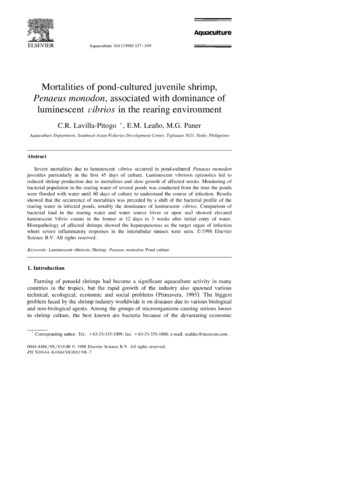WSSV risk factors related to water physico-chemical properties and microflora in semi-intensive Penaeus monodon culture ponds in the Philippines
| dc.contributor.author | Tendencia, Eleonor | |
| dc.contributor.author | Bosma, Roel H. | |
| dc.contributor.author | Verreth, Johan A. J. | |
| dc.date.accessioned | 2014-05-29T06:38:08Z | |
| dc.date.available | 2014-05-29T06:38:08Z | |
| dc.date.issued | 2010 | |
| dc.identifier.citation | Tendencia, E. A., Bosma, R. H., & Verreth, J. A. J. (2010). WSSV risk factors related to water physico-chemical properties and microflora in semi-intensive Penaeus monodon culture ponds in the Philippines. Aquaculture, 302(3-4), 164-168. | en |
| dc.identifier.issn | 0044-8486 | |
| dc.identifier.uri | http://hdl.handle.net/10862/2110 | |
| dc.description.abstract | Whitespot syndrome virus, WSSV, is the most important among the shrimp diseases. One of the suggested WSSV risk factors is the occurrence of stress since stressors could compromise the shrimp defence system thus increasing the risk of WSSV infection. Stressors are usually related to the physico-chemical properties of both water and pond bottom. This paper investigates the effect of some biotic and abiotic components of the pond ecosystem on WSSV infection and outbreak. Water physico-chemical properties and microflora of 91 production cycles of 8 semi-intensive shrimp farms were analyzed to determine WSSV risk factors, using factor analysis and logistic regression. Fluctuations of temperature and pH are important risk factors that will result to an infection but not necessarily to an outbreak. Exposure to high salinity and high temperature are important factors for an infection to result to an outbreak. The risk of an infection is reduced when the water temperature is high, salinity fluctuations are small, and percentage of yellow Vibrio colonies is greater than the green ones. Further studies are needed to clarify the effects of water depth, water transparency, and various bacterial counts; these factors could be individual or interactive. | en |
| dc.description.sponsorship | The authors wish to thank the Government of Japan for funding the study under the trust fund granted to SEAFDEC (GoJ TFD FH0206). | en |
| dc.language.iso | en | en |
| dc.publisher | Elsevier | en |
| dc.subject | Penaeus monodon | en |
| dc.subject | Vibrio | en |
| dc.subject | Philippines | en |
| dc.title | WSSV risk factors related to water physico-chemical properties and microflora in semi-intensive Penaeus monodon culture ponds in the Philippines | en |
| dc.type | Article | en |
| dc.identifier.doi | 10.1016/j.aquaculture.2010.03.008 | |
| dc.citation.volume | 302 | |
| dc.citation.issue | 3-4 | |
| dc.citation.spage | 164 | |
| dc.citation.epage | 168 | |
| dc.citation.journalTitle | Aquaculture | en |
| dc.subject.asfa | bacterial diseases | en |
| dc.subject.asfa | fish diseases | en |
| dc.subject.asfa | husbandry diseases | en |
| dc.subject.asfa | White spot syndrome virus | en |
| dc.subject.asfa | pond culture | en |
| dc.subject.asfa | ponds | en |
| dc.subject.asfa | risk | en |
| dc.subject.asfa | shrimp culture | en |
| dc.subject.asfa | symptoms | en |
| dc.subject.asfa | water transparency | en |
| dc.subject.scientificName | Penaeus monodon | en |
Files in this item
| Files | Size | Format | View |
|---|---|---|---|
|
There are no files associated with this item. |
|||
This item appears in the following Collection(s)
-
Journal Articles [1258]
These papers were contributed by Department staff to various national and international journals.




